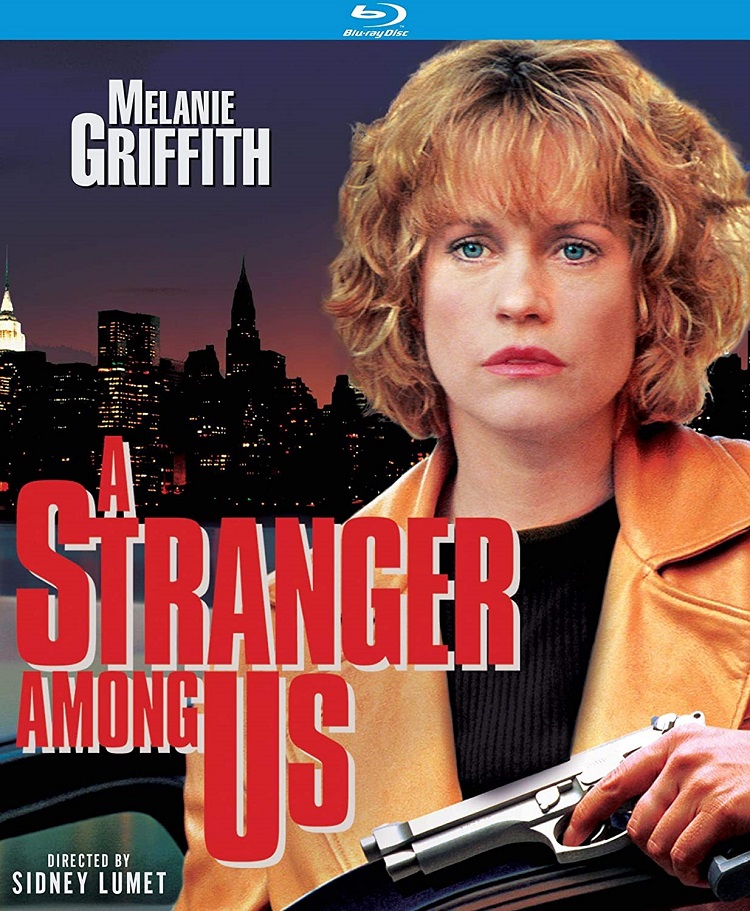
A Stranger Among Us is a strange film. At times a crime thriller, a romance, a fish-out-of-water story, and a golden-toned New York story about a little-known or filmed community. It didn’t get very good reviews when it was originally released in 1992, with many reviewers feeling that the story was weak and its star, Melanie Griffith, was woefully miscast as a hard-boiled New York cop. Has anything changed since then? Well, yes and no.
Melanie Griffith’s best films (Body Double, Stormy Monday, Something Wild) contrast her kewpie doll voice with the brains behind the bod, as she told Harrison Ford in Working Girl, so it is reasonable, if not entirely believable, that she is a world-weary New York City cop. It’s at least necessary for the plot to proceed. In A Stranger Among Us, she plays Emily Eden, a cop going through the motions in her life – sleeping with her partner Nick (Jamey Sheridan) and looking for her job to provide thrills (she is trigger-happy and rarely calls for back-up). Nick is clearly enamored of her:
“Are we in love?”
“We’re in lust”
Poor Nick gets wounded after she has them pursue two suspects without calling it in first. He survives, and Emily is sent on a routine missing persons case as a quasi-punishment. Now we get to the part of the film that director Sidney Lumet (Network, 12 Angry Men, The Verdict, Dog Day Afternoon, Running On Empty) is clearly most interested in. He tells us this in the opening aerial shots of New York City, including the World Trade Center, which pan from the Verrazano to the Manhattan Bridge and the neighborhood below, his object, the day-to-day life of a Brooklyn Hasidic community.
Lumet lights all of the interiors of the Hasidim with a golden glow that suggests candlelight. He is definitely romaticizing these people’s lives as well as trying to portray a people living in a protected pocket (out of time?) in the middle of the big brash city. The Hasidim stay within their neighborhood, read their own newspapers in their own language, and study ancient religious texts. When they do venture out, they are transported by bus to midtown, to work in the diamond district. It’s an enclosed world, which at first seems strange and oppressive to Emily.
The missing persons case quickly turns into a murder investigation and Emily must live among the Hasidim to crack the case. She is a woman without commitments – no serious or steady boyfriend (sorry, Nick) and she barely sees her retired cop dad. She finds their foreign customs at first fascinating, like a tourist, and then begins to observe a deeper meaning to their rituals. While undercover, she is as attracted to the sense of community and family as much as she is to the handsome young Ariel (Eric Thal, in his first role), a scholar of the Kabbalah and the best friend of the missing man. The two begin to grow closer, against all odds and traditions.
Eric Thal (The Puppet Masters, Six Degrees of Separation) reportedly auditioned for a small part in the film, and Lumet was so impressed with him that he gave him the lead role of Ariel. His portrayal of the earnest and soft-spoken but deep feeling Ariel is the best part of the movie. You might not be interested in whether Emily solves the mystery, but you’ll very likely be interested in Ariel. It was Thal’s first film. He doesn’t seem to act as much these days, but he has founded an American accent school for actors, American English Master, which seems to keep him busy.
James Gandolfini can also be spotted in an early small role as a wise guy who is one of Emily’s prime suspects. Viewers may find the movie’s plot as disjointed as the world the Hasidim inhabit, with the crime being investigated its least convincing part. But A Stranger Among Us is still an interesting watch. The viewer, like Emily, may feel like a fish out of water watching the rules and customs of the Brooklyn Hasidim, but they will be captivated in the neighborhood and the character of Ariel as well.
A Stranger Among Us is in color, and rated PG-13, with a running time of 109 minutes and an aspect ratio of (1.85:1) 1920x1080p. Images look great on a large-scale high-definition television screen, especially those golden interiors filmed by cinematographer Andrzej Bartkowiak. English subtitles are available.
Extras on the Blu-ray Include an audio Commentary by Screenwriter Robert J. Avrech and theatrical trailers for A Stranger Among Us, V.I. Warshawski, One Good Cop, Cherry 2000, Born Yesterday, Paradise, Two Much, The Offence and The Group.